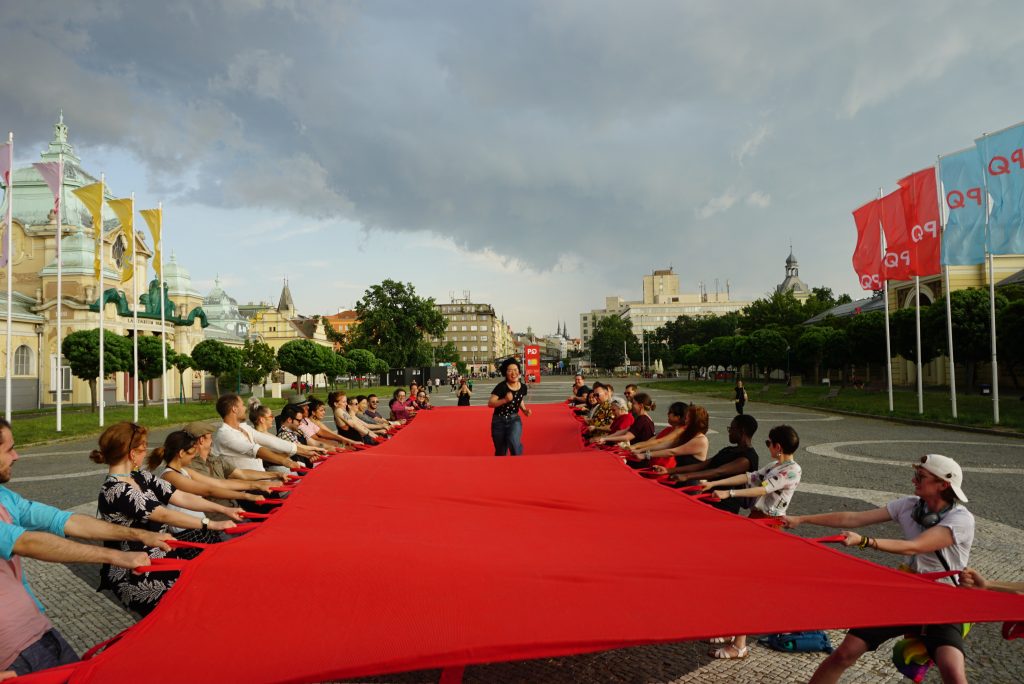 Red Crossing is a participatory public performance, centered on a custom-built red walkway that can be lifted like a life saving net allowing pedestrians to float a few feet above the ground. This project –which has been deployed at Somerset House in London (part of Now Play This 2022) The Museum of Textile and Industry, Augsburg, Germany (2021) The Winnipeg Design Festival (2020) and Formations, an exhibition of The Prague Quadrennial of Performance Design and Space 2019. The project is a collaboration between Nick Tobier / EverydayPlaces and Roland Graf / Assocreation with production assistance by Jennifer Low.
Red Crossing is a participatory public performance, centered on a custom-built red walkway that can be lifted like a life saving net allowing pedestrians to float a few feet above the ground. This project –which has been deployed at Somerset House in London (part of Now Play This 2022) The Museum of Textile and Industry, Augsburg, Germany (2021) The Winnipeg Design Festival (2020) and Formations, an exhibition of The Prague Quadrennial of Performance Design and Space 2019. The project is a collaboration between Nick Tobier / EverydayPlaces and Roland Graf / Assocreation with production assistance by Jennifer Low.
Red Crossing at the Prague Industrial Exhibition grounds subverts the existing 19th + 20th century geometries and patterns engineered to serve technical and functional aspects of control and circulation. While the straight paths and repeated geometry directs visitors to follow the way to the Palace –whether for consumption, spectatorship, or culture contained in exhibition halls – we can pick up our walkway and slice the plaza diagonally or invent rhythms based on foot traffic to make an approach that matches the time of the day. This strategy builds on the 1960’s experimental urban planning actions of the Situationist International tactic dérive (driftage), or to wander through an urban area and disobey those signs whose purpose it is to channel human behavior (e.g. traffic signs, advertisements, designation/segregation of public and private spaces) to subvert top-down planning as an alienating and isolating external form of control (Wigley, Mark, 1988). Stepping up, in more ways than one, Red Crossing seeks to create physically and socially intelligent structures that facilitate cooperation, emotional release and transcend the expectations of architecture and infrastructure as fixed. Emboldening viewers to become participants, the experience of building is part of the installation.
In his scholarship of social movement via the internet Brett Rolfe (Rolfe, 2005) introduces the idea of “innovative hothouses” – small and specialized pioneering communities which aim at exploiting all opportunities of that medium. With means such as mail-bombing or net strikes, these innovations are deployed by activist artists and other groups adding to the repertoire of online social forums, Red Crossing’s promise is to articulate a concept akin to the hothouse metaphor to demonstrate the impact of artists’ practices on collective action offline.
Red Crossing grows in magnitude with participation, displacing not only passive spectatorship, but also associations with international aid as something received and of mobility and border crossings as points of control. Our team of uniformed walkway-operators serve as a kind of on the ground air traffic controller. Our red shoes, vests and traffic batons beckon passers-by to join us. By conducting call and response calls to action on site, the pathways we form will be created both by our operators and our visitors. If you can envision a giant game of Twister, or the effect of an invitation to join a red carpet event, then you can start to envision our emergent forms. Our Red Cross(ing) is one of mutual aid that begs the questions of how more public spaces and spheres could be continually in formation, built and re-fashioned, not only by municipal authority and not solely for efficiency or control, but rather for a flexible and welcoming dynamism.
Red Crossing challenges the assumptions of human movement and flow through public space. It transforms utility and municipal authority into buoyancy and collective action through continuous formations and re-formations of its bouncing surface, its surrounding supporters, and the performers moving across it.
In 2023, Red Crossing appeared in Ulanbataar, Mongolia at Magic Land 2 as a guest of Nomadic Red Corner and 976 Art Gallery.